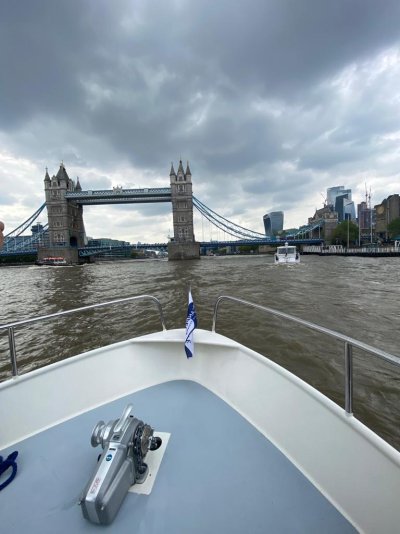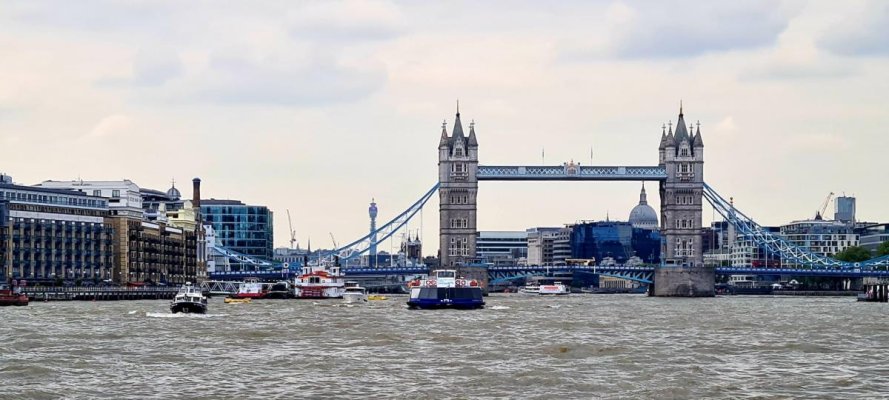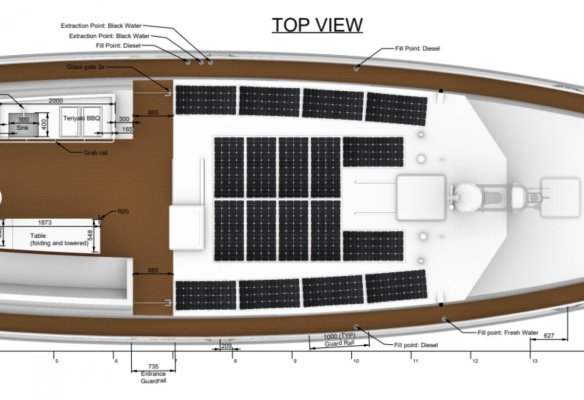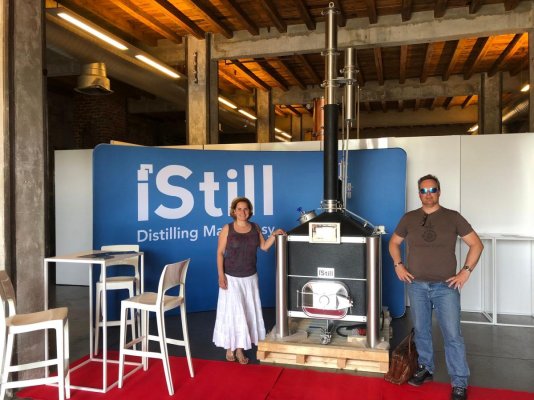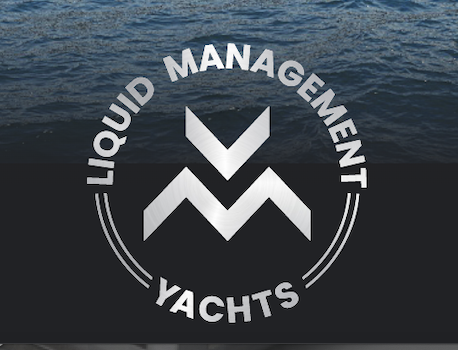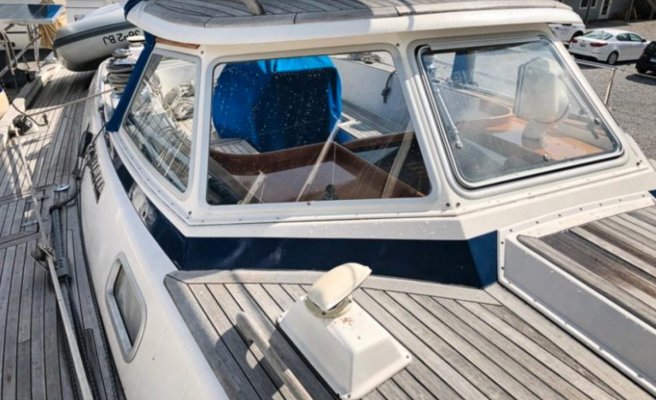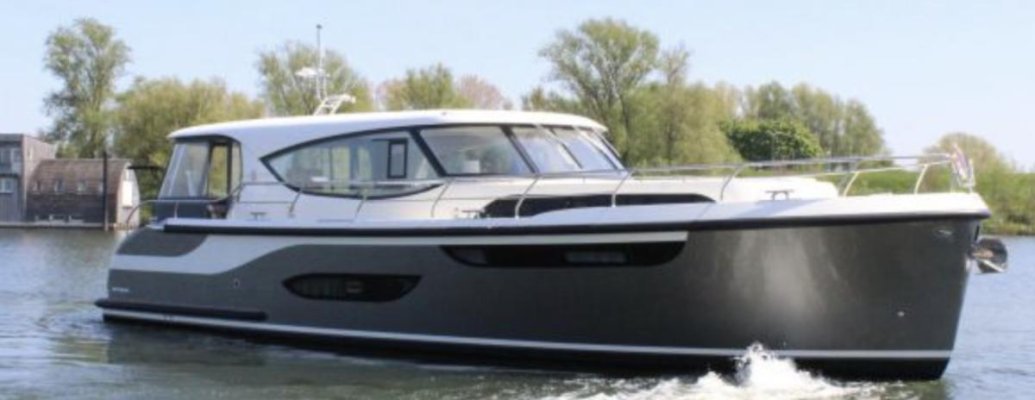I just discovered this thread and read the whole thing end to end. What an exciting project! I have had many fantasies of doing something similar, but I am not quite rich enough yet. the FPB 64 has been at the top of my list as #1 dream boats for years, so I definitely appreciate the path you are going down.Reading 20+ pages of this thread I have so many opinions on different aspects of your design you have discussed. I will list some of my thoughts, I will dwell on the negatives, but don't take this as me not liking what you are doing. I love 90% of it, these are just the things I would want to personally change.
1. I understand what you are trying to do with the main helm, and the seating situation, and I think it would be fine for coastal cruising, but I don't think you will be happy with it for crossing oceans. Sitting up at the helm seat will not be that comfortable for hours on end especially with rough weather and side to side motion, and you will want to kick back more. To do this you will go sit in the L shaped couch behind, but then the turned around bench will be in the way when you want to get back to the helm to check your electronics, etc. My suggestion is to get rid of the two fixed seats on the Starboard side, and replace them with two nice Sidd style helm chairs on 5 leg mobile bases. Devise a way to bolt the bases down easily in a few different locations. At anchor they will live on the port side. On passage, the aft one will live bolted down right in front of the helm, and the bench will get bolted down in it's place on the starboard side of the cabin. That way you will have two nice helm chairs at the front of the pilot house during passages. They will also be great places to perch when at anchor. My last boat was set up with a mobile helm chair similar to this, and it was better than I ever would have imagined it would be. When at anchor the way you have it will be magic.
2. I would put a nice big hatch or dorade vent over the guest shower. It would be a great place to get lots of air flow through the boat, but if spray or rain got in it, it would be no big deal as it would just be in the shower and wouldn't hurt anything.
3. I would put a lip all the way around the main cabin roof so that any rain or salt spray that gets on the roof won't drip off, hit the deck, then splash on the windows. Much better to have it all run back to a couple of drains, and exit the roof in a controlled manner. Also good for collecting rain water. In cold rainy climates it will keep all the water off the windows when you are at anchor, and help keep condensation problems to a minimum.
4. I might misunderstand the plan, but it looks to me like the only door to exit the boat is a sailboat style companion way, with a short door and sliding top. This would be way too big a compromise for me. I would either want a doghouse so I could have a full height door, which would block the rear helm view, or a hard dodger so it could be opened in the rain and especially salt spray during a crossing, without getting a bunch of salt water inside the boat. I actually kind of like the idea of a hard dodger there, and moving the outdoor helm up to the back of the cabin under it. This would keep all the electronics dry and out of the sun too, which would be nice. At 10 kn upwind in any type of offshore sea, I would imagine that this is going to be a very wet boat, with tons of spray coming over it continuously. A covered outside area would be nice.
5. I would want some way to control the boat in harbor situations from the bow for anchoring, picking up moorings, etc. With no side doors in the pilot house, it is a long way from your helm to your anchor! This could be as simple as a nice wired remote tied into your microcomander engine controls, autopilot steering, thrusters, etc. A few companies make nice versions of these. Would also be really nice for docking when you are by yourself. Would also be nice to have a depth display up there you could see while you were anchoring, doesn't need to be anything fancy. Would also be nice if you could integrate a good place for a couple people to sit on the bow. Could be as easy as sloping the front of the cabin at a good angle so can sit on the deck on a boat cushion and comfortably lean back against the cabin front.
6. This would not be a big problem where I normally cruise as we have tons of super protected anchorages, but if I were going world cruising in this boat I would be afraid of it being really tender in anchorages that aren't very protected. with it's light weight, slender beam, light displacement, and shallow draft, I could imagine it being a big problem in many areas. I think the FPB solved this with flopper stoppers on paravane poles. My last boat had paravanes stabilizers, and flopper stoppers, and they worked really well. Adding them would add weight aloft, windage, cost, and shadows for the solar, So I can see why you wouldn't want to go down that road. I think you mentioned electric stabilizer as some point, which my be able to provide some zero speed stabilization?
7. I think the kite is a dumb idea. In my option the best thing about a trawler is that when the weather suddenly goes to ****, and all hell breaks loose, you don't have to go outside. The last thing I want to do in the middle of the ocean, with my wife sleeping at 2 am, is go fight some kite that is at risk due to the unexpected thunder storm cell that just rolled through. If you want to sail build a sail boat, or motor sailor. I do love a good motorsailer, and wish there were more good options in that regard.
8. I don't think your dingy storage on the transom will be satisfactory for high latitude ocean travel. If you have it lashed down hard enough, it might be safe, but I think you will get in situations where you have waves breaking completely over the dingy, and even if it is safe, it will be unnerving, and super hard on the engine and controls. You mentioned early on that it could be stored in the cockpit, but I don't see how that would work with the current plan.
9. If you could do it structurally, and design wise, I think it would be nice to have a small section of the deck on the starboard side that stepped down a couple steps, and have a side door in the house that opened up onto it. Again, if it was possible structurally, it would be nice to have a side door in the hull there to have a low spot to step off onto the dock from. I think your current boat might be set up this way. Wouldn't have to be a full height door. Put the door in the middle between the two mobile pilot chairs.

10. If I was building this project, especially if going with single screw as I think you are planning, I would make whatever compromises necessary to go keel cooled/dry stack. The keel cooling is super easy on an aluminum boat. My last boat was set up this way and it was so nice. Zero salt water on the engines. No raw water pump impeller to screw up or change, no Zincs to worry about, no strainer to clog up, no exhaust elbow to corrode, no chance of flooding muffler and salt water in the engine, no heat exchanger to corrode or plug up. It eliminates so many things that need maintenance or can break down. Would add to peace of mind crossing oceans on a single screw.
11. From the renderings you have posted I don't find the look of your design beautiful, or sexy. I have a hard time putting my finger on exactly why. For the record I am in love with the looks of the FPB's , and the XPM 78 so it's not that I don't like the look of this type of boat. The first thing I don't like is the reverse bow. I think it would look way better with just a couple of inches of positive rake on the bow. I am sure you could add a small bulb low down to get the exact same performance, but I think it would look better. The other thing is a harder nut to crack in terms of how I would fix it. I think the rear cockpit and height required for the aft state room make it look too tall in the aft end. This is a very common problem with most boats with aft cabins, and while I get the utility of the design, it is hard thing to make sexy. One thing that I think would help right off the bat would be to show the side doors of the aft cockpit closed in the render, so it didn't look like a separate little house, but more visually connected to the main house. There might be some paint trick that would help, like painting a line from the bottom of the seat backs up a lighter color to make it appear not as tall. See attached picture for the boat with a rear cabin/cockpit that is the best I have ever seen visually. I also think I hard dodger over the back of the house, and the front of the cockpit might help make it look nicer, but hard to say without seeing it rendered.


